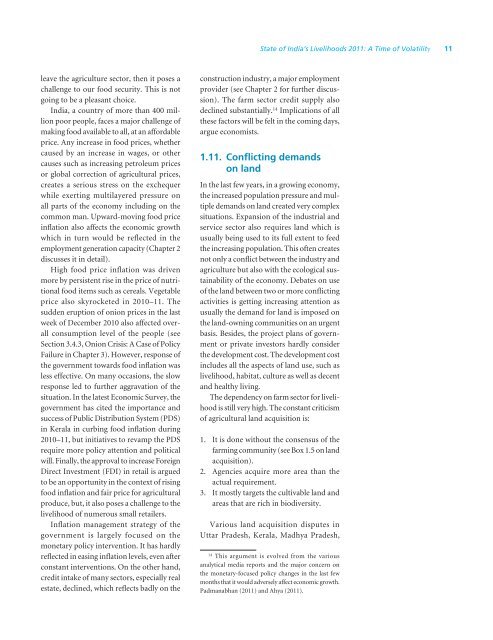SOIL Report 2011 - ACCESS Development Services
SOIL Report 2011 - ACCESS Development Services
SOIL Report 2011 - ACCESS Development Services
- No tags were found...
You also want an ePaper? Increase the reach of your titles
YUMPU automatically turns print PDFs into web optimized ePapers that Google loves.
State of India’s Livelihoods <strong>2011</strong>: A Time of Volatility 11leave the agriculture sector, then it poses achallenge to our food security. This is notgoing to be a pleasant choice.India, a country of more than 400 millionpoor people, faces a major challenge ofmaking food available to all, at an affordableprice. Any increase in food prices, whethercaused by an increase in wages, or othercauses such as increasing petroleum pricesor global correction of agricultural prices,creates a serious stress on the exchequerwhile exerting multilayered pressure onall parts of the economy including on thecommon man. Upward-moving food priceinflation also affects the economic growthwhich in turn would be reflected in theemployment generation capacity (Chapter 2discusses it in detail).High food price inflation was drivenmore by persistent rise in the price of nutritionalfood items such as cereals. Vegetableprice also skyrocketed in 2010–11. Thesudden eruption of onion prices in the lastweek of December 2010 also affected overallconsumption level of the people (seeSection 3.4.3, Onion Crisis: A Case of PolicyFailure in Chapter 3). However, response ofthe government towards food inflation wasless effective. On many occasions, the slowresponse led to further aggravation of thesituation. In the latest Economic Survey, thegovernment has cited the importance andsuccess of Public Distribution System (PDS)in Kerala in curbing food inflation during2010–11, but initiatives to revamp the PDSrequire more policy attention and politicalwill. Finally, the approval to increase ForeignDirect Investment (FDI) in retail is arguedto be an opportunity in the context of risingfood inflation and fair price for agriculturalproduce, but, it also poses a challenge to thelivelihood of numerous small retailers.Inflation management strategy of thegovernment is largely focused on themonetary policy intervention. It has hardlyreflected in easing inflation levels, even afterconstant interventions. On the other hand,credit intake of many sectors, especially realestate, declined, which reflects badly on theconstruction industry, a major employmentprovider (see Chapter 2 for further discussion).The farm sector credit supply alsodeclined substantially. 14 Implications of allthese factors will be felt in the coming days,argue economists.1.11. Conflicting demandson landIn the last few years, in a growing economy,the increased population pressure and multipledemands on land created very complexsituations. Expansion of the industrial andservice sector also requires land which isusually being used to its full extent to feedthe increasing population. This often createsnot only a conflict between the industry andagriculture but also with the ecological sustainabilityof the economy. Debates on useof the land between two or more conflictingactivities is getting increasing attention asusually the demand for land is imposed onthe land-owning communities on an urgentbasis. Besides, the project plans of governmentor private investors hardly considerthe development cost. The development costincludes all the aspects of land use, such aslivelihood, habitat, culture as well as decentand healthy living.The dependency on farm sector for livelihoodis still very high. The constant criticismof agricultural land acquisition is:1. It is done without the consensus of thefarming community (see Box 1.5 on landacquisition).2. Agencies acquire more area than theactual requirement.3. It mostly targets the cultivable land andareas that are rich in biodiversity.Various land acquisition disputes inUttar Pradesh, Kerala, Madhya Pradesh,14This argument is evolved from the variousanalytical media reports and the major concern onthe monetary-focused policy changes in the last fewmonths that it would adversely affect economic growth.Padmanabhan (<strong>2011</strong>) and Ahya (<strong>2011</strong>).














